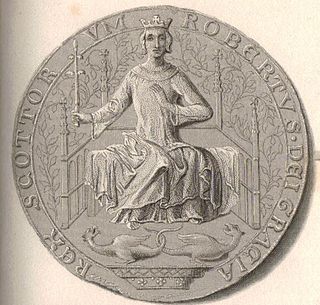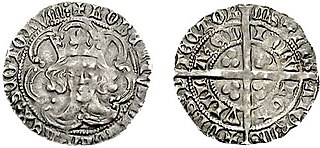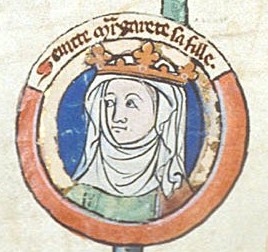
Robert II was King of Scots from 1371 to his death in 1390. The son of Walter Stewart, 6th High Steward of Scotland, and Marjorie, daughter of King Robert the Bruce, he was the first monarch of the House of Stewart. Upon the death of his uncle David II, Robert succeeded to the throne.

Robert III, born John Stewart, was King of Scots from 1390 to his death in 1406. He was also High Steward of Scotland from 1371 to 1390 and held the titles of Earl of Atholl (1367–1390) and Earl of Carrick (1368–1390) before ascending the throne at about the age of 53 years. He was the eldest son of King Robert II and Elizabeth Mure and was legitimized by the second marriage of his parents and by papal dispensation in 1349.

Saint Margaret of Scotland, also known as Margaret of Wessex, was an English princess and a Scottish queen. Margaret was sometimes called "The Pearl of Scotland". Born in the Kingdom of Hungary to the expatriate English prince Edward the Exile, Margaret and her family returned to England in 1057. Following the death of Harold Godwinson at the Battle of Hastings in 1066, her brother Edgar Ætheling was elected as King of England but never crowned. After she and her family fled north, Margaret married Malcolm III of Scotland by the end of 1070.

Robert Stewart, Duke of Albany was a member of the Scottish royal family who served as regent to three Scottish monarchs. A ruthless politician, Albany was widely regarded as having murdered his nephew, the Duke of Rothesay, and brother to the future King James I of Scotland. James was held in captivity in England for eighteen years, during which time Albany served as regent in Scotland, king in all but name. He died in 1420 and was succeeded by his son, Murdoch Stewart, Duke of Albany, who was executed for treason when James returned to Scotland in 1425, almost causing the complete ruin of the Albany Stewarts.

Alexander Stewart, Earl of Buchan, called the Wolf of Badenoch, was the third surviving son of King Robert II of Scotland by his first wife Elizabeth Mure. Alexander married the widowed Euphemia I, Countess of Ross, but they had no children. He did have a large family by his longtime mistress, Mairead inghean Eachainn.

Donnchadh was a Gall-Gaidhil prince and Scottish magnate in what is now south-western Scotland, whose career stretched from the last quarter of the 12th century until his death in 1250. His father, Gille-Brighde of Galloway, and his uncle, Uhtred of Galloway, were the two rival sons of Fergus, Prince or Lord of Galloway. As a result of Gille-Brighde's conflict with Uhtred and the Scottish monarch William the Lion, Donnchadh became a hostage of King Henry II of England. He probably remained in England for almost a decade before returning north on the death of his father. Although denied succession to all the lands of Galloway, he was granted lordship over Carrick in the north.

Scotland in the Middle Ages concerns the history of Scotland from the departure of the Romans to the adoption of major aspects of the Renaissance in the early sixteenth century.
Cailean of Carrick or Cailean mac Donnchadh was the son of Donnchadh, Earl of Carrick, and probably the father of Niall, Earl of Carrick. Although once heir to the earldom of Carrick, Cailean appears to have died before 1250.

Columba de Dunbar was Bishop of Moray from 1422 until his death at Spynie Palace near Elgin sometime before 7 November 1435.

Andrew Stewart was a 15th-century Scottish prelate and administrator.
Michael Hunter Brown is a Scottish medievalist lecturing at the University of St Andrews. In 1991 he was the recipient of the Royal Historical Society's David Berry Prize. His volume on the reign of King James I of Scotland led to the award of the Agnes Mure prize for Scottish history. Brown's work is concentrated on late Medieval Scotland and its nobility. He is married to Margaret Connolly who also works at the University of St Andrews as a medievalist.

Duncan Campbell, 1st Lord Campbell (Classical Gaelic Donnchadh mac Cailein, and also called Donnchadh na-Adh of Loch Awe,, was a Scottish nobleman and politician. He was an important figure in Scottish affairs in the first half of the 15th century and Justiciar of Argyll. He was head of the Clan Campbell for 40 years.
Walter de Coventre was a 14th-century Scottish ecclesiastic. There is no direct evidence of his birthdate, his family, or his family's origin, although he may have come from the region around Abernethy, where a family with the name de Coventre is known to have lived. Walter appeared in the records for the first time in the 1330s, as a student at the University of Paris. From there he went on to the University of Orléans, initially as a student before becoming a lecturer there. He studied the arts, civil law and canon law, and was awarded many university degrees, including two doctorates. His studies were paid for, at least partially, by his benefices in Scotland. Despite holding perhaps more than five benefices at one stage, he did not return to Scotland until the late 1350s.
John Gallda MacDougall, also known as John MacDougall, and John Macdougall, and in Gaelic as Eoin MacDubhghaill, Eoin Gallda MacDubhghaill, Eòin Gallda MacDubhghaill, and Eóin Gallda Mac Dubhghaill, was a fourteenth-century Scottish magnate. He was a grandson of John MacDougall, Lord of Argyll, a man who had been forced from Scotland into exile in the first third of the century. It was under John Gallda that the MacDougall leadership made its resurgence in Scotland after generations of English exile.

Clann Ruaidhrí was a leading medieval clan in the Hebrides and the western seaboard of Scotland. The eponymous ancestor of the family was Ruaidhrí mac Raghnaill, a principal member of Clann Somhairle in the thirteenth century. Members of Clann Ruaidhrí were factors in both the histories of the Kingdom of the Isles and the Kingdom of Scotland in the thirteenth- and fourteenth centuries. The family appears to have held power in Kintyre in the thirteenth century. By the fourteenth century, the family controlled an extensive provincial lordship stretching along north-western Scottish coast and into the Hebrides. As a leading force in the Kingdom of the Isles, the family fiercely opposed Scottish authority. With the collapse of Norwegian hegemony in the region, the family nimbly integrated itself into the Kingdom of Scotland.

Christina of the Isles was a fourteenth-century Scottish noblewoman. She was the daughter of Ailéan mac Ruaidhrí and a leading member of Clann Ruaidhrí. Although Ailéan had two sons, Lachlann and Ruaidhrí, both appear to have been illegitimate, whereas Christina was legitimate, and possibly a daughter of Ailéan's wife, Isabella.
Dubhghall mac Suibhne was a Scottish landholder in Argyll, and a leading member of Clann Suibhne. He was a son of Suibhne mac Duinn Shléibhe, and appears to have held lordship of Knapdale from at least the 1240s to the 1260s, and may have initiated the construction of Skipness Castle and Lochranza Castle.
Murchadh Mac Suibhne was a leading member of Clann Suibhne. He was a grandson of the family's eponymous ancestor Suibhne mac Duinn Shléibhe, and a nephew of the family's mid-thirteenth-century representative, Dubhghall mac Suibhne.

Government in medieval Scotland, includes all forms of politics and administration of the minor kingdoms that emerged after the departure of the Romans from central and southern Britain in the fifth century, through the development and growth of the combined Scottish and Pictish kingdom of Alba into the kingdom of Scotland, until the adoption of the reforms of the Renaissance in the fifteenth century.
Raghnall Mac Ruaidhrí was an eminent Scottish magnate and chief of Clann Ruaidhrí. Raghnall's father, Ruaidhrí Mac Ruaidhrí, appears to have been slain in 1318, at a time when Raghnall may have been under age. Ruaidhrí himself appears to have faced resistance over the Clann Ruaidhrí lordship from his sister, Cairistíona, wife of Donnchadh, a member of the comital family of Mar. Following Ruaidhrí's demise, there is evidence indicating that Cairistíona and her powerful confederates also posed a threat to the young Raghnall. Nevertheless, Raghnall eventually succeeded to his father, and first appears on record in 1337.












